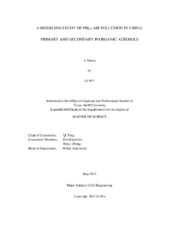A Modeling Study of PM2.5 Air Pollution in China: Primary and Secondary Inorganic Aerosols
Abstract
Quantitative information on sources and source region contributions to particulate matter (PM) concentration in China is currently poorly understood but is urgently needed to make emission control strategies. In this study, source-oriented Community Multi-scale Air Quality (CMAQ) models are used to study the formation of and source contributions to primary and secondary PM in China.
The results show that inter-regional transport of sulfate, nitrate and ammonium ion (SNA) occurs frequently, especially in the winter. The emissions from non-local regional can contribute 30-70% of the total SNA in different regions and seasons. It is also found that surface heterogeneous reactions of NO2 and SO2 and higher emissions of NH3 are needed to better reproduce the observed high concentrations of SNA in Beijing, and potentially in other areas. Residential sources account for significant fractions (19%-68% in Beijing and 6%-30% in Shanghai) of primary PM2.5, with higher contributions occur in winter. Industrial emissions are important throughout the year (15%-45% in Beijing and 39%-60% in Shanghai). Dust contributions can be as much as 20-30% in spring and fall seasons. Contributions to primary PM2.5 from other sources are relatively small. In Shanghai, local emissions account for 70-90 % of primary PM2.5. However, local emissions only contribute to 45%-55% of primary PM2.5 in Beijing. These suggest that inter-regional emission control strategies are necessary to reduce PM pollution in China. Source and source region contributions to primary PM2.5 components are determined using a novel multi-linear regression technique that combines the observation data and the source-oriented model predictions of primary PM2.5 mass concentrations.
Citation
Wu, Li (2015). A Modeling Study of PM2.5 Air Pollution in China: Primary and Secondary Inorganic Aerosols. Master's thesis, Texas A & M University. Available electronically from https : / /hdl .handle .net /1969 .1 /155144.


